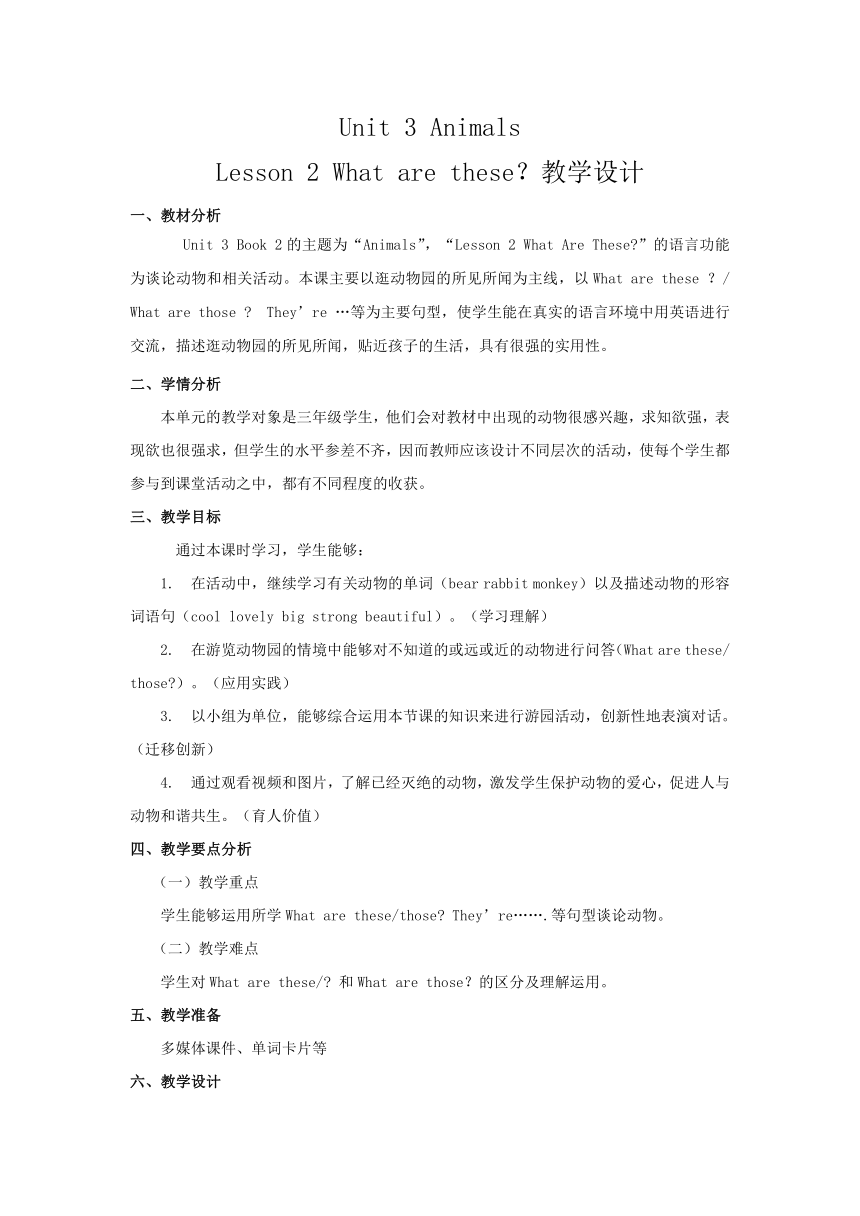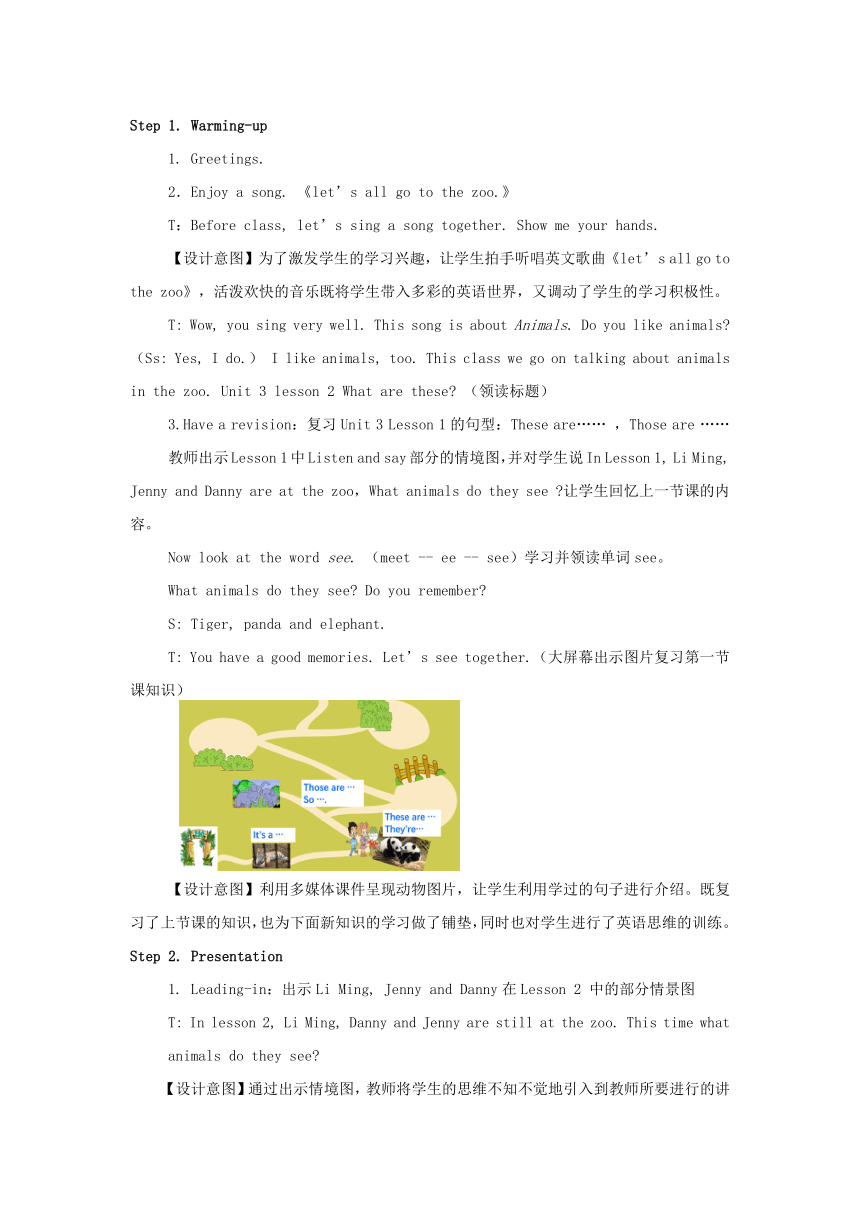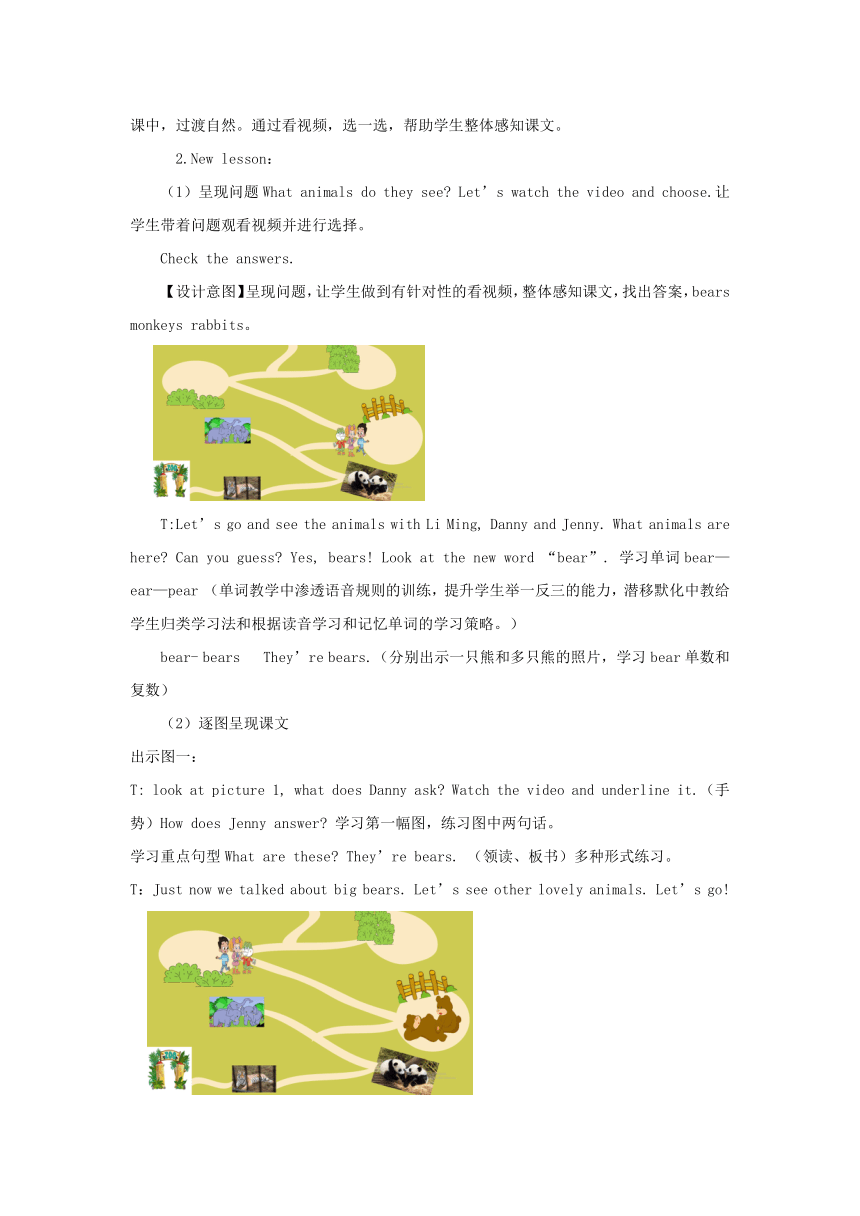Unit 3 Lesson 2 What are these? 教学设计
文档属性
| 名称 | Unit 3 Lesson 2 What are these? 教学设计 |

|
|
| 格式 | docx | ||
| 文件大小 | 3.2MB | ||
| 资源类型 | 教案 | ||
| 版本资源 | 鲁科版(五四制) | ||
| 科目 | 英语 | ||
| 更新时间 | 2024-04-26 09:57:19 | ||
图片预览



文档简介
Unit 3 Animals
Lesson 2 What are these?教学设计
一、教材分析
Unit 3 Book 2的主题为“Animals”,“Lesson 2 What Are These ”的语言功能为谈论动物和相关活动。本课主要以逛动物园的所见所闻为主线,以What are these ?/ What are those They’re …等为主要句型,使学生能在真实的语言环境中用英语进行交流,描述逛动物园的所见所闻,贴近孩子的生活,具有很强的实用性。
二、学情分析
本单元的教学对象是三年级学生,他们会对教材中出现的动物很感兴趣,求知欲强,表现欲也很强求,但学生的水平参差不齐,因而教师应该设计不同层次的活动,使每个学生都参与到课堂活动之中,都有不同程度的收获。
三、教学目标
通过本课时学习,学生能够:
1. 在活动中,继续学习有关动物的单词(bear rabbit monkey)以及描述动物的形容词语句(cool lovely big strong beautiful)。(学习理解)
2. 在游览动物园的情境中能够对不知道的或远或近的动物进行问答(What are these/ those )。(应用实践)
3. 以小组为单位,能够综合运用本节课的知识来进行游园活动,创新性地表演对话。(迁移创新)
4. 通过观看视频和图片,了解已经灭绝的动物,激发学生保护动物的爱心,促进人与动物和谐共生。(育人价值)
四、教学要点分析
(一)教学重点
学生能够运用所学What are these/those They’re…….等句型谈论动物。
(二)教学难点
学生对What are these/ 和What are those?的区分及理解运用。
五、教学准备
多媒体课件、单词卡片等
六、教学设计
Step 1. Warming-up
1. Greetings.
2.Enjoy a song. 《let’s all go to the zoo.》
T:Before class, let’s sing a song together. Show me your hands.
【设计意图】为了激发学生的学习兴趣,让学生拍手听唱英文歌曲《let’s all go to the zoo》,活泼欢快的音乐既将学生带入多彩的英语世界,又调动了学生的学习积极性。
T: Wow, you sing very well. This song is about Animals. Do you like animals (Ss: Yes, I do.) I like animals, too. This class we go on talking about animals in the zoo. Unit 3 lesson 2 What are these (领读标题)
3.Have a revision:复习Unit 3 Lesson 1的句型:These are…… ,Those are ……
教师出示Lesson 1中Listen and say部分的情境图,并对学生说In Lesson 1, Li Ming, Jenny and Danny are at the zoo,What animals do they see 让学生回忆上一节课的内容。
Now look at the word see. (meet -- ee -- see)学习并领读单词see。
What animals do they see Do you remember
S: Tiger, panda and elephant.
T: You have a good memories. Let’s see together.(大屏幕出示图片复习第一节课知识)
【设计意图】利用多媒体课件呈现动物图片,让学生利用学过的句子进行介绍。既复习了上节课的知识,也为下面新知识的学习做了铺垫,同时也对学生进行了英语思维的训练。
Step 2. Presentation
Leading-in:出示Li Ming, Jenny and Danny在Lesson 2 中的部分情景图
T: In lesson 2, Li Ming, Danny and Jenny are still at the zoo. This time what animals do they see
【设计意图】通过出示情境图,教师将学生的思维不知不觉地引入到教师所要进行的讲课中,过渡自然。通过看视频,选一选,帮助学生整体感知课文。
2.New lesson:
(1)呈现问题What animals do they see Let’s watch the video and choose.让学生带着问题观看视频并进行选择。
Check the answers.
【设计意图】呈现问题,让学生做到有针对性的看视频,整体感知课文,找出答案,bears monkeys rabbits。
T:Let’s go and see the animals with Li Ming, Danny and Jenny. What animals are here Can you guess Yes, bears! Look at the new word “bear”. 学习单词bear—ear—pear (单词教学中渗透语音规则的训练,提升学生举一反三的能力,潜移默化中教给学生归类学习法和根据读音学习和记忆单词的学习策略。)
bear- bears They’re bears.(分别出示一只熊和多只熊的照片,学习bear单数和复数)
(2)逐图呈现课文
出示图一:
T: look at picture 1, what does Danny ask Watch the video and underline it.(手势)How does Jenny answer 学习第一幅图,练习图中两句话。
学习重点句型What are these They’re bears. (领读、板书)多种形式练习。
T:Just now we talked about big bears. Let’s see other lovely animals. Let’s go!
T: Class, what animals are here Yes, rabbits! Let’s look at the word “rabbit”
(学习a和 i 的发音)
rabbit– rabbits They’re rabbits. (分别出示一只兔子和多只兔子的照片,学习rabbit单数和复数)
出示图二
Read Picture 2 by yourselves and practice in pairs.(因为第二幅图中的对话和第一幅图基本一样,所以在学习生单词rabbit之后,同桌俩练习第二幅图中的对话就行。)
T: Look at the picture, Jenny is feeding the rabbits. Class, can we feed animals at the zoo Yes No In the zoo, some animals can be fed, but some animals can’t. We should follow the rules. And good behavior makes us be civilized tourists.
T: Let’s see the last animal. What animals are here Let’s listen.(播放猴子叫声)Yes, monkeys! Look at the word “monkey”(学习o 的发音)
monkey- monkeys They’re monkeys. (分别出示一只猴子和多只猴子的照片,学习monkey单数和复数)
出示图三
T: Class, look at the third picture, listen and fill in the blanks. (第三幅图听录音填空 What are those 领读、板书 重点练习)
出示图四
T: Now let’s listen to the last picture and fill.(学习最后一幅图)
【设计意图】多种形式逐图学习课文,让学生边学习,边思考问题,透彻地了解本课对话内容,这样既训练了学生的听力,吸引了学生的注意力,又培养了学生动脑思考的学习习惯。
(2)Let’s go back to the story.(回顾课文)
T: Class, why here we use “these” and here we use “those” Yes, when animals are near, we use “what are these ” When animals are far, we use “ What are those ” (回顾课文,讲解these 和those的区别,讲解中老师用手势和肢体语言帮助学生进行near 和far的理解。)
Let’s practice.(通过fill in the blanks趁热打铁练习these和those用法,用来针对学生对这两个句型的理解情况进行反馈)
(3)Let’s listen, point and imitate. Two tips for you.
学生打开课文,看课文,听录音,边听边指读。老师在学生跟读到重点句子What are these?和What are those?时分别让多个个别学生起来repeat,以确定学生掌握了正确的发音,和模仿到了纯正的语音语调,并及时地纠错和鼓励学生。
【设计意图】 一定要让学生指读课文,因为三年级的学生学习英语的习惯还有待进一步养成。尤其是学生普遍存在着能听会说但不认识单词和句子的现象,所以更要做进一步强调和要求。
(4)Let’s role-play. Read the text in 3 and play the roles.
学生三人一组分角色朗读和表演课文,老师巡视指导。然后让小组在班里展示。
【设计意图】在此过程中,学生可以扮演不同的角色,不仅学得较好的学生有收获,掌握不太好的学生也有所得。能够充分照顾到不同水平和层次的学生,让他们体验到学习英语的快乐。另外还培养了学生的合作意识和团体精神,活跃了课堂气氛。
Step 3. Practice
Pair work: Play a guessing game:(练习书上let’s talk部分)
多媒体课件呈现被遮住身体的动物的图片,教师问:What are these?让学生猜They’re …….
(老师先带领学生一起做一个What are these 和What are those的图片,剩下的图片同桌之间练习,最后展示)
【设计意图】让每个学生都能在轻松愉快的氛围中操练语句,调动学生口、眼、耳、脑的参与,激发兴趣,加深印象,使新知识在游戏中得到延伸练习和拓展。
Step 4. Consolidation
T: Class, just now we learn about bears、rabbits and monkeys. Do you know other animals (拓展其他动物 lions zebras penguins,为接下来的小组合作做准备)
Group work: (小组合作)
Dear students,
We will build a big zoo(建一个大型动物园) in Laizhou. Can you help us to design an ideal zoo (设计一个理想的动物园)for us You can send the pictures to us.
Email: 6895234@
Laizhou Zoo
【设计意图】这一环节通过让学生画自己理想的动物园并介绍动物,既复习了前一节课学习的动物,又巩固了本单元学过的动物单词,同时还激发了学生的学习兴趣。有效的实现了知识的拓展运用同时也加强了学生间的合作精神。
T:These animals are so lovely,right? But some animals are pitiful. Let’s see the pictures. They’re lovely but they’re dying out.
T:Class, animals are our friends, we should love them and protect them. Don’t let man be the last animal.
【设计意图】通过观看视频和欣赏图片,提示学生要保护动物,要和动物交朋友。抓住契机对学生进行情感教育。
Step 5. Let’s check.
That’s all for this class. Let’s have a check.
【设计意图】让学生对本节课的重点知识进行检测,完成达标。
Step 6. Homework
I think this class you did a good job. You’re great! For today’s homework:
1. Must do(必做):
Listen and imitate the text three time. (模仿跟读课文三遍)
2. Choose to do(选做):
Draw a poster of animal protection.(画一张保护动物的海报)
【设计意图】为使课堂内外形成一个完整的体系,作业的设计可以进一步提高学生运用语言的能力,使学生学以致用,感受成功的喜悦。
板书设计
Unit 3 Animals
Lesson 2 What are these
What are these bears.
They’re monkeys.
What are those rabbits.
Lesson 2 What are these?教学设计
一、教材分析
Unit 3 Book 2的主题为“Animals”,“Lesson 2 What Are These ”的语言功能为谈论动物和相关活动。本课主要以逛动物园的所见所闻为主线,以What are these ?/ What are those They’re …等为主要句型,使学生能在真实的语言环境中用英语进行交流,描述逛动物园的所见所闻,贴近孩子的生活,具有很强的实用性。
二、学情分析
本单元的教学对象是三年级学生,他们会对教材中出现的动物很感兴趣,求知欲强,表现欲也很强求,但学生的水平参差不齐,因而教师应该设计不同层次的活动,使每个学生都参与到课堂活动之中,都有不同程度的收获。
三、教学目标
通过本课时学习,学生能够:
1. 在活动中,继续学习有关动物的单词(bear rabbit monkey)以及描述动物的形容词语句(cool lovely big strong beautiful)。(学习理解)
2. 在游览动物园的情境中能够对不知道的或远或近的动物进行问答(What are these/ those )。(应用实践)
3. 以小组为单位,能够综合运用本节课的知识来进行游园活动,创新性地表演对话。(迁移创新)
4. 通过观看视频和图片,了解已经灭绝的动物,激发学生保护动物的爱心,促进人与动物和谐共生。(育人价值)
四、教学要点分析
(一)教学重点
学生能够运用所学What are these/those They’re…….等句型谈论动物。
(二)教学难点
学生对What are these/ 和What are those?的区分及理解运用。
五、教学准备
多媒体课件、单词卡片等
六、教学设计
Step 1. Warming-up
1. Greetings.
2.Enjoy a song. 《let’s all go to the zoo.》
T:Before class, let’s sing a song together. Show me your hands.
【设计意图】为了激发学生的学习兴趣,让学生拍手听唱英文歌曲《let’s all go to the zoo》,活泼欢快的音乐既将学生带入多彩的英语世界,又调动了学生的学习积极性。
T: Wow, you sing very well. This song is about Animals. Do you like animals (Ss: Yes, I do.) I like animals, too. This class we go on talking about animals in the zoo. Unit 3 lesson 2 What are these (领读标题)
3.Have a revision:复习Unit 3 Lesson 1的句型:These are…… ,Those are ……
教师出示Lesson 1中Listen and say部分的情境图,并对学生说In Lesson 1, Li Ming, Jenny and Danny are at the zoo,What animals do they see 让学生回忆上一节课的内容。
Now look at the word see. (meet -- ee -- see)学习并领读单词see。
What animals do they see Do you remember
S: Tiger, panda and elephant.
T: You have a good memories. Let’s see together.(大屏幕出示图片复习第一节课知识)
【设计意图】利用多媒体课件呈现动物图片,让学生利用学过的句子进行介绍。既复习了上节课的知识,也为下面新知识的学习做了铺垫,同时也对学生进行了英语思维的训练。
Step 2. Presentation
Leading-in:出示Li Ming, Jenny and Danny在Lesson 2 中的部分情景图
T: In lesson 2, Li Ming, Danny and Jenny are still at the zoo. This time what animals do they see
【设计意图】通过出示情境图,教师将学生的思维不知不觉地引入到教师所要进行的讲课中,过渡自然。通过看视频,选一选,帮助学生整体感知课文。
2.New lesson:
(1)呈现问题What animals do they see Let’s watch the video and choose.让学生带着问题观看视频并进行选择。
Check the answers.
【设计意图】呈现问题,让学生做到有针对性的看视频,整体感知课文,找出答案,bears monkeys rabbits。
T:Let’s go and see the animals with Li Ming, Danny and Jenny. What animals are here Can you guess Yes, bears! Look at the new word “bear”. 学习单词bear—ear—pear (单词教学中渗透语音规则的训练,提升学生举一反三的能力,潜移默化中教给学生归类学习法和根据读音学习和记忆单词的学习策略。)
bear- bears They’re bears.(分别出示一只熊和多只熊的照片,学习bear单数和复数)
(2)逐图呈现课文
出示图一:
T: look at picture 1, what does Danny ask Watch the video and underline it.(手势)How does Jenny answer 学习第一幅图,练习图中两句话。
学习重点句型What are these They’re bears. (领读、板书)多种形式练习。
T:Just now we talked about big bears. Let’s see other lovely animals. Let’s go!
T: Class, what animals are here Yes, rabbits! Let’s look at the word “rabbit”
(学习a和 i 的发音)
rabbit– rabbits They’re rabbits. (分别出示一只兔子和多只兔子的照片,学习rabbit单数和复数)
出示图二
Read Picture 2 by yourselves and practice in pairs.(因为第二幅图中的对话和第一幅图基本一样,所以在学习生单词rabbit之后,同桌俩练习第二幅图中的对话就行。)
T: Look at the picture, Jenny is feeding the rabbits. Class, can we feed animals at the zoo Yes No In the zoo, some animals can be fed, but some animals can’t. We should follow the rules. And good behavior makes us be civilized tourists.
T: Let’s see the last animal. What animals are here Let’s listen.(播放猴子叫声)Yes, monkeys! Look at the word “monkey”(学习o 的发音)
monkey- monkeys They’re monkeys. (分别出示一只猴子和多只猴子的照片,学习monkey单数和复数)
出示图三
T: Class, look at the third picture, listen and fill in the blanks. (第三幅图听录音填空 What are those 领读、板书 重点练习)
出示图四
T: Now let’s listen to the last picture and fill.(学习最后一幅图)
【设计意图】多种形式逐图学习课文,让学生边学习,边思考问题,透彻地了解本课对话内容,这样既训练了学生的听力,吸引了学生的注意力,又培养了学生动脑思考的学习习惯。
(2)Let’s go back to the story.(回顾课文)
T: Class, why here we use “these” and here we use “those” Yes, when animals are near, we use “what are these ” When animals are far, we use “ What are those ” (回顾课文,讲解these 和those的区别,讲解中老师用手势和肢体语言帮助学生进行near 和far的理解。)
Let’s practice.(通过fill in the blanks趁热打铁练习these和those用法,用来针对学生对这两个句型的理解情况进行反馈)
(3)Let’s listen, point and imitate. Two tips for you.
学生打开课文,看课文,听录音,边听边指读。老师在学生跟读到重点句子What are these?和What are those?时分别让多个个别学生起来repeat,以确定学生掌握了正确的发音,和模仿到了纯正的语音语调,并及时地纠错和鼓励学生。
【设计意图】 一定要让学生指读课文,因为三年级的学生学习英语的习惯还有待进一步养成。尤其是学生普遍存在着能听会说但不认识单词和句子的现象,所以更要做进一步强调和要求。
(4)Let’s role-play. Read the text in 3 and play the roles.
学生三人一组分角色朗读和表演课文,老师巡视指导。然后让小组在班里展示。
【设计意图】在此过程中,学生可以扮演不同的角色,不仅学得较好的学生有收获,掌握不太好的学生也有所得。能够充分照顾到不同水平和层次的学生,让他们体验到学习英语的快乐。另外还培养了学生的合作意识和团体精神,活跃了课堂气氛。
Step 3. Practice
Pair work: Play a guessing game:(练习书上let’s talk部分)
多媒体课件呈现被遮住身体的动物的图片,教师问:What are these?让学生猜They’re …….
(老师先带领学生一起做一个What are these 和What are those的图片,剩下的图片同桌之间练习,最后展示)
【设计意图】让每个学生都能在轻松愉快的氛围中操练语句,调动学生口、眼、耳、脑的参与,激发兴趣,加深印象,使新知识在游戏中得到延伸练习和拓展。
Step 4. Consolidation
T: Class, just now we learn about bears、rabbits and monkeys. Do you know other animals (拓展其他动物 lions zebras penguins,为接下来的小组合作做准备)
Group work: (小组合作)
Dear students,
We will build a big zoo(建一个大型动物园) in Laizhou. Can you help us to design an ideal zoo (设计一个理想的动物园)for us You can send the pictures to us.
Email: 6895234@
Laizhou Zoo
【设计意图】这一环节通过让学生画自己理想的动物园并介绍动物,既复习了前一节课学习的动物,又巩固了本单元学过的动物单词,同时还激发了学生的学习兴趣。有效的实现了知识的拓展运用同时也加强了学生间的合作精神。
T:These animals are so lovely,right? But some animals are pitiful. Let’s see the pictures. They’re lovely but they’re dying out.
T:Class, animals are our friends, we should love them and protect them. Don’t let man be the last animal.
【设计意图】通过观看视频和欣赏图片,提示学生要保护动物,要和动物交朋友。抓住契机对学生进行情感教育。
Step 5. Let’s check.
That’s all for this class. Let’s have a check.
【设计意图】让学生对本节课的重点知识进行检测,完成达标。
Step 6. Homework
I think this class you did a good job. You’re great! For today’s homework:
1. Must do(必做):
Listen and imitate the text three time. (模仿跟读课文三遍)
2. Choose to do(选做):
Draw a poster of animal protection.(画一张保护动物的海报)
【设计意图】为使课堂内外形成一个完整的体系,作业的设计可以进一步提高学生运用语言的能力,使学生学以致用,感受成功的喜悦。
板书设计
Unit 3 Animals
Lesson 2 What are these
What are these bears.
They’re monkeys.
What are those rabbits.
同课章节目录
- Unit 1 Food and Drinks
- Lesson 1 I like eggs.
- Lesson 2 Do you like fish?
- Lesson 3 I'd like some apple juice.
- Lesson 4 Again,please!
- Unit 2 Clothes
- Lesson 1 I have a new sweater.
- Lesson 2 Is this your cap?
- Lesson 3 Whose coat is this?
- Lesson 4 Again,please!
- Unit 3 Animals
- Lesson 1 These are pandas.
- Lesson 2 What are these?
- Lesson 3 How many monkeys can you see?
- Lesson 4 Again,please!
- Unit 4 Home
- Lesson 1 We have a big living room.
- Lesson 2 I read in my bedroom.
- Lesson 3 Where's Danny?
- Lesson 4 Again,please!
- Unit 5 School
- Lesson 1 Is this your classroom?
- Lesson 2 It's on the first floor.
- Lesson 3 We read in the library.
- Lesson 4 Again,please!
- Unit 6 Time
- Lesson 1 It's seven 0'clock.
- Lesson 2 It's time for class.
- Lesson 3 I get up at seven.
- Lesson 4 Again,please!
